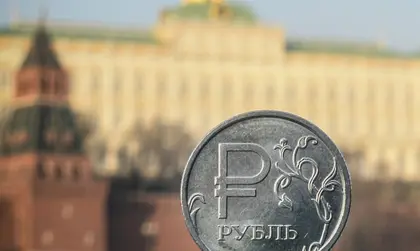Russia’s efforts to reduce the rapid depreciation of the ruble continue to be unsuccessful after it slid past 100 against the dollar on Monday – its lowest level since March 23, 2022.
JOIN US ON TELEGRAM
Follow our coverage of the war on the @Kyivpost_official.
The Russian Central Bank’s tactic of no longer purchasing foreign currencies, but rather taking the surplus currency out of circulation by keeping larger ruble notes, has done little to calm public jitters.
- Find the newest Ukraine news pieces that came out today.
- Russian Losses
Oleksandr Lugovskyy, Ph.D., an American economist originally from Ukraine, told Kyiv Post that while the current value “in and of itself it does not change anything,” the 100 mark against the US dollar “may be an important mental threshold."
This echoes what another economist told Kyiv Post earlier this month – Russians are becoming spooked, and recent Ukrainian drone strikes, in Moscow specifically, may have caused the upper class there to sense that the war was no longer distant, shaking public confidence that the country was stable.
Over the past month, the ruble has lost more than 12 percent against the US dollar and nearly 8 percent against the euro. Despite officially trading at 101 to the dollar and 110 to the euro on Tuesday, private banks in Russia gave clear signs of uncertainty as to how far the Ruble would fall.
On Tuesday afternoon, Russia’s Tinkoff Bank, which is under UK and European sanctions, was selling US dollars at 106.4 and euros at 114.2. Alfa Bank, formerly owned by EU, UK – and as of Friday US – sanctioned oligarchs Mikhail Friedman and Peter Aven, was purchasing dollars at 105.77 and euros at 111.56.

Russia Closes Airports Amid Widespread Drone Attacks as Ukraine Repels Massive UAV Assault
Despite exchange rates typically differing little more than 1-2 percent between the buy and sale price, Tinkoff Bank on Monday was buying US dollars at 96.1 and euros at 95 – roughly 10 percent spread, roughly the same as the spread seen at Alfa Bank.
Lugovskyy explained to Kyiv Post that the unusually large “width of the bid-ask spread is due to the risk related to any ruble trades.”
He added: “Liquidity risk is one of the drivers of the bid-ask spread as the ruble is not a tradable currency.”
“Volatility is another type of risk that is factored in: The ruble’s exchange rate has been very unstable in the last 18 months, hence we are seeing the spreads widening.”
Economists tend to agree that the ruble, having already lost more than half of its value since the beginning of the year, is hurting common Russians, but not in a way that has drastically affected their quality of life.
A poll done in Russia last week found that 45 percent of Russians spend more than half of their income on food, and 43 percent spend 30-50 percent of their money to purchase food. In contrast, the average American spends 30 percent of their income on food.
Lugovskyy added: “That the ruble is not dropping sharply is due primarily to stringent controls on its trading.”
But will it continue to decline? “I expect it to continue to creep down, but not necessarily plummeting (yet),” said the Ukrainian-American economist.
You can also highlight the text and press Ctrl + Enter






